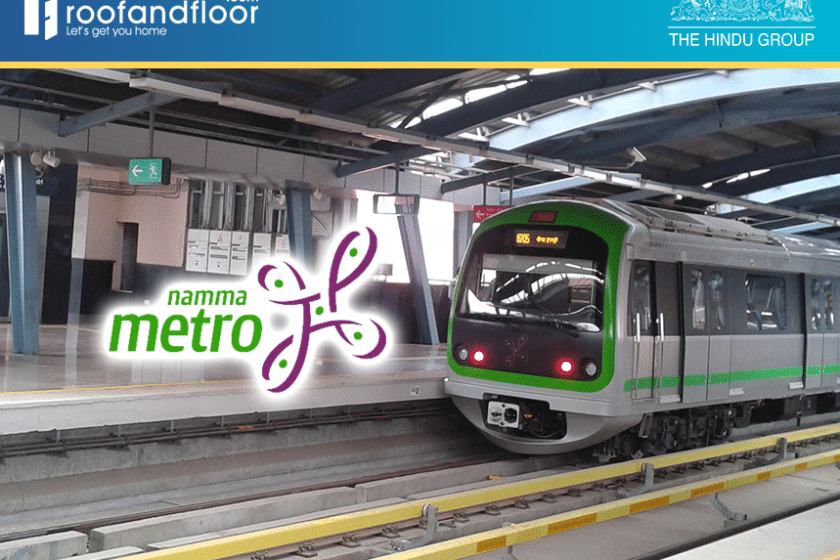Bangalore’s growth over the past decade and more has been staggering. The once sleepy city that was affectionately called a ‘Pensioner’s Paradise’ has transformed itself into a chaotic, bustling IT hub that hustles with pubs and jostles for space. Nothing has epitomised Bangalore’s haphazard growth more than its increasingly bewildering traffic conditions. Distance, they say, in Bangalore is measured with time and not kilometres. For the tired Bangalorean, hope beams on the horizon with the impending completion of its beloved Namma Metro project.
With the ridership of Namma Metro currently at 150,000 a day, and steadily increasing, Bangaloreans are hoping that the BMRCL (Bangalore Metro and Rail Corporation) finishes working on Namma Metro Phase 2 as soon as possible.
The BMRCL has granted the contract to private firm Simplex Infrastructure Ltd., and work has begun in earnest.
Namma Metro Phase 2 has been divided into six reaches, with each extension progressing at a different pace.
Reach 2
Work is proceeding rapidly on this stretch of the metro as all the properties that form a part of this extension have already been acquired by the BMRCL.
This undertaking is the extension of the Purple Line from Mysore Road to Kengeri and will join two areas that are separated by 8 kilometres. This will help drastically reduce the travel time between these two areas, and give the long-suffering residents of Mysore Road a reason to rejoice.
Reach 4
Just like Reach 2, work on the Reach 4 extension is progressing quickly as the government has already acquired the land. This is the extension of the Green Line and will connect Yelachenahalli to Anjanapura Township, making access to these two areas a lot easier.
Both Reach 2 and Reach 4 were scheduled to be completed by 2020. However, the Union Minister for Urban Development, M. Venkaiah Naidu has promised that both Reach 2 and Reach 4 should be completed by the end of 2018, a full two years ahead of schedule!
Reach 1
The Reach 1 extension starts from one of the main metro stations constructed during Phase I – the Baiyappanahalli Metro station. This extension will span over 15.5 km, all the way from Whitefield to Baiyappanahalli.
Construction of this extension is yet to begin, as property acquisition for this project is still underway. However, most of the area required to complete this stretch has already been paid for and is under the ownership of the BMRCL.
Reach 3
Around Rs 30 crores have already been paid as compensation for land to construct Reach 3 of the metro. This extension will cover 3.03 km, from Hesaraghatta Cross to BIEC, and will have three metro stations – at Manjunathanagar, BIEC, and Jindal.
Reach 5 and 6
Reach 5 will span over 18.5 km, between Silk Board and Bommasandra, and Rs 208 crores have already been paid to acquire land for its construction.
Reach 6 will cover the distance between Gottigere and Nagawara, and land acquisition is underway.
Work on both these extensions is yet to begin and should start by early 2018.
More trains. More frequency.
The BMRCL anticipates that once Phase I is fully open, there will be an increase in ridership. And considering that parts of Phase II will soon become operational, they have decided to double the number of coaches per train, from three to six.
In April 2017, the BMRCL placed an order for 6-coach trains, which are to be supplied by Bharath Earth Movers, a public sector company under the Ministry of Defence. They were the ones who supplied the three-car trains for the Metro, and recently won a contract of Rs. 1,421 crores to supply 150 sets of cars for Phase II of the Metro.
Problems may persist
Namma Metro is sure to face major problems in the intervening months between the opening of the underground section and the arrival of the six-train cars. The supply of cars will begin by June 2018 and complete only by the end of 2019. Until then, passengers will have to deal with crowded cars.
But a brighter future awaits
Taking various factors into consideration, the BMRCL has decided to increase the frequency of trains to every three minutes during peak hours, to support the increased traffic.
The Namma Metro is sure to facilitate enhanced connectivity within the city and improve Bangalore’s status as one of the finest cities to live in India. It has taken its own sweet time to get here, but hopefully, Bangalore’s traffic woes might cease.



Efficient public transport decrease the load on road traffic. Example Mumbai locals. Trains are bulk carriers of passengers. The more they expand the less pressure on roads. Trains (Metros) are cheap, fast and are usually maintain time.Less congestion and traffic jams on road.